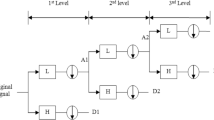Abstract
A reliable process making use of adaptive filtering, adaptive wavelet transform (AWT) and adaptive neuro-fuzzy inference system (ANFIS) is proposed for automatic identification of defect in the bearing. The process starts with denoising the signal using a filter designed from the noise part in the signal itself using the least mean square algorithm. Thereafter, AWT is applied to denoised signal to produce AWT scalogram. AWT scalogram clearly gives time location information corresponding to burst produced due to defect. For carrying out AWT, a wavelet is designed from the burst produced to defect using the least square fitting method. Then instantaneous energy (IE) of AWT scalogram is computed. For modeling of ANFIS, features are extracted from signal denoised by adaptive filtering, AWT scalogram and IE graph. The dimension of features is reduced by kernel principal component analysis. ANFIS modeling is carried out using low-dimensional kernel principal components. Finally, defect identification is carried out by applying test features kernel principal components to ANFIS. The proposed method has a recognition rate of 100%. Major benefit of the proposed method is that it requires very less training data and also does not require any optimization algorithm, usually required to find optimum parameters of a pattern recognition model. The method proposed in this work can fulfill the industrial requirement of having sophisticated and accurate automatic defect identification model.



















Similar content being viewed by others
References
Bingzhen J, Jiawei X, Yanxue W (2014) Rolling bearing fault diagnosis approach based on PPCA denoising and cyclic bispectrum method. J Vib Control 22:2420–2433
Borghesani P, Pennacchi P, Chatterton S (2014) The relationship between Kurtosis- and envelope-based indexes for the diagnostic of rolling element bearings. Mech Syst Signal Process 43:25–43
Yang Y, Yu DJ, Cheng JS (2006) A roller bearing fault diagnosis method based on EMD energy entropy and ANN. J Sound Vib 294:269–277
Hu C, Peng Z (2016) Frequency band selection based on the kurtosis of the squared envelope spectrum and its application in bearing fault diagnosis. Proc IMechE Part C J Mech Eng Sci. doi:10.1177/0954406215595655
Wang H, Chen J, Dong G (2014) Fault diagnosis of rolling bearing’s early weak fault based on minimum entropy de-convolution and fast Kurtogram algorithm. Proc IMechE Part C J Mech Eng Sci. doi:10.1177/0954406214564692
Elasha F, Mba D, Ruiz-Carcel C (2016) A comparative study of adaptive filters in detecting a naturally degraded bearing within a gearbox. Case Stud Mech Syst Signal Process 3:1–8
Wang T, Liang M, Li J, Cheng W, Li C (2015) Bearing fault diagnosis under unknown variable speed via gear noise cancellation and rotational order sideband identification. Mech Syst Signal Process 62–63:30–53
Kumar A, Kumar R (2016) Enhancing weak defect features using undecimated and adaptive wavelet transform for estimation of roller defect size in a bearing. Tribol Trans. doi:10.1080/10402004.2016.1213343
Kumar A, Kumar R (2016) Manifold learning using linear local tangent space alignment (LLTSA) algorithm for noise removal in wavelet filtered vibration signal. J Nondestruct Eval 35:50. doi:10.1007/s10921-016-0366-4
Qiu H, Lee J, Lin J, Yu G (2006) Wavelet filter-based weak signature detection method and its application on rolling element bearing prognostics. J Sound Vib 289:1066–1090
Ertunc HM, Ocak H, Aliustaoglu C (2013) ANN- and ANFIS-based multi-staged decision algorithm for the detection and diagnosis of bearing faults. Neural Comput Appl 22(Suppl 1):S435–S446. doi:10.1007/s00521-012-0912-7
Wulandhari LA, Wibowo A, Desa MI (2015) Condition diagnosis of multiple bearings using adaptive operator probabilities in genetic algorithms and back propagation neural networks. Neural Comput Appl 26:57–65. doi:10.1007/s00521-014-1698-6
Acharya UR, Bhat PS, Lyengar SS, Rao A, Dua S (2003) Classification of heart rate data using artificial neural network and fuzzy equivalence relation. Pattern Recognit 36:61–68
Hariharan M, Paulraj MP, Yaacob S (2011) Detection of vocal fold paralysis and oedema using time-domain features and probabilistic neural network. Int J Biomed Eng Technol 6:46–57
Samanta B, Al-Balushi KR, Al-Araimi SA (2003) Artificial neural networks and support vector machines with genetic algorithm for bearing fault detection. Eng Appl Artif Intell 16:657–665
Zhang X, Zhou J (2013) Multi-fault diagnosis for rolling element bearings based on ensemble empirical mode decomposition and optimized support vector machines. Mech Syst Signal Process 41:127–140
Zhu K, Song X, Xue D (2014) A roller bearing fault diagnosis method based on hierarchical entropy and support vector machine with particle swarm optimization algorithm. Measurement 47:669–675
Matlab user’s guide. 2015. The MathWorks Inc., Natick
Patel VN, Tandon N, Pandey RK (2012) Improving defect detection of rolling element bearings in the presence of external vibrations using adaptive noise cancellation and multiscale morphology. Proc IMechE Part J J Eng Tribol 226:150–162
Yan R, Gao RX, Chen X (2014) Wavelets for fault diagnosis of rotary machines: a review with applications. Signal Process. 96:1–15
Scholkopf B, Smola A, Muller KR (1998) Nonlinear component analysis as a Kernel eigenvalue problem. Neural Comput 10:1299–1319
Li J, Li X, Tao D (2008) KPCA for semantic object extraction in images. Pattern Recognit 41:3244–3250
Yuan Z, Wang L-N, Ji X (2014) Prediction of concrete compressive strength: research on hybrid models genetic based algorithms and ANFIS. Adv Eng Softw 67:156–163
Sadrmomtazia A, Sobhani J (2013) Modeling compressive strength of EPS lightweight concrete using regression, neural network and ANFIS. Constr Build Mater 42:205–216
Naderloo L, Alimardani R, Omid M, Sarmadian F, Javadikia P, Torabi MY, Alimardani F (2012) Application of ANFIS to predict crop yield based on different energy inputs. Measurement 45:1406–1413
Acknowledgements
The authors are thankful to Editor for facilitating reviewer’s feedback to the manuscript. The valuable suggestions of anonymous reviewers in improving the manuscript are thankfully acknowledged.
Author information
Authors and Affiliations
Corresponding author
Ethics declarations
Conflict of interest
The authors declare that there is no actual or potential conflict of interest in relation to this article.
Rights and permissions
About this article
Cite this article
Kumar, A., Kumar, R. Adaptive artificial intelligence for automatic identification of defect in the angular contact bearing. Neural Comput & Applic 29, 277–287 (2018). https://doi.org/10.1007/s00521-017-3123-4
Received:
Accepted:
Published:
Issue Date:
DOI: https://doi.org/10.1007/s00521-017-3123-4




